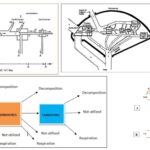IB Biology 59 Views 1 Answers
Sourav PanLv 9November 9, 2024
How do neurons pump sodium and potassium ions across their membranes to generate a resting potential?
How do neurons pump sodium and potassium ions across their membranes to generate a resting potential?
Please login to save the post
Please login to submit an answer.
Sourav PanLv 9May 15, 2025
Neurons generate a resting potential through the active transport of sodium (Na++) and potassium (K++) ions across their membranes, primarily facilitated by the sodium-potassium pump (Na+/K++/K+-ATPase). This process establishes and maintains the necessary ionic gradients that allow neurons to be electrically excitable.
Mechanism of Sodium-Potassium Pump
- Active Transport:
The sodium-potassium pump is an active transporter that uses energy from ATP hydrolysis to move ions against their concentration gradients. For every cycle of the pump:- 3 sodium ions are transported out of the neuron.
- 2 potassium ions are transported into the neuron.
This unequal exchange results in a net loss of positive charge from the cell, contributing to a more negative internal environment compared to the outside.
- Establishing Ionic Gradients:
The pump maintains high concentrations of Na++ outside the neuron and K++ inside. At rest, neurons are much more permeable to K++ than to Na++. As K++ ions leak out through potassium leakage channels, the internal charge becomes more negative, leading to a typical resting membrane potential of approximately -70 mV. - Membrane Potential:
The resting potential is primarily determined by:- The concentration gradients of Na++ and K++.
- The selective permeability of the neuronal membrane to these ions. Since the membrane is more permeable to K++, it allows more K++ to exit than Na++ to enter, reinforcing the negative charge inside the neuron.
Importance of Resting Potential
The resting potential is crucial for several reasons:
- Electrical Excitability: It creates a polarized state that enables neurons to respond quickly to stimuli by generating action potentials when depolarization occurs.
- Signal Transmission: The maintenance of this potential ensures that neurons can efficiently transmit signals along their axons and communicate with other neurons or muscles
0
0 likes
- Share on Facebook
- Share on Twitter
- Share on LinkedIn
0 found this helpful out of 0 votes
Helpful: 0%
Helpful: 0%
Was this page helpful?




